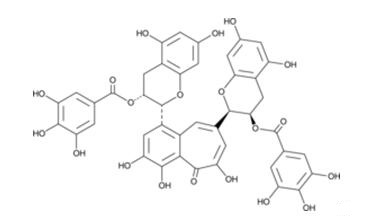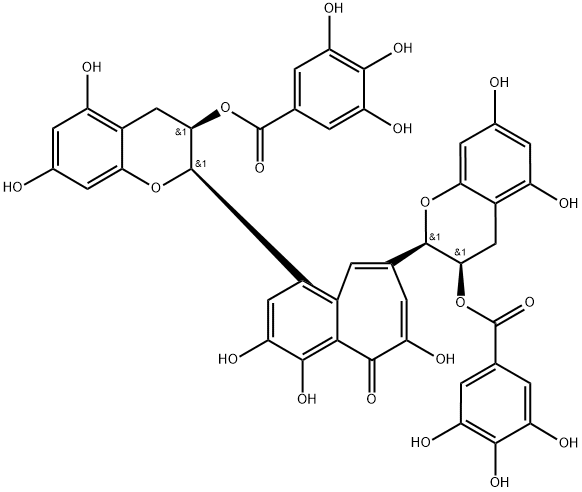Theaflavin 3,3'-digallate – a polyphenol in black tea
Theaflavin-3,3'-digallate (TFDG) is a major polyphenol found in black tea with diverse biological activities [1,2,3]. It has antioxidant activity, inhibiting the formation of superoxide radicals, singlet oxygen, hydrogen peroxide, and hydroxyl radicals in vitro (IC50s = 26.7, 0.83, 0.39, and 25.07 µmol/L, respectively) [1]. It also reduces hydroxyl radical-induced damage to plasmid DNA. TFDG (12.5-50 µM) prevents LPS-induced release of TNF-α, IL-1β, and IL-6, expression of JNK and p38, and nuclear translocation of NF-κB in RAW 264.7 cells [2]. In vivo, TFDG reduces serum levels of TNF-α, IL-1β, and IL-6 and decreases pulmonary edema, pulmonary congestion, and thickening of the alveolar wall in a mouse model of LPS-induced acute lung injury. It also inhibits osteoclast formation, polarization, and osteoclastic bone resorption in vitro and reduces titanium particle-induced bone erosion and the number of mature osteoclasts in mice in a dose-dependent manner [3].

Black tea theaflavins are a mixture of theaflavin, theaflavin-3-gallate, theaflavin-3'-gallate, and theaflavin-3,3'-digallate. Although the human oral cavity is the initial site exposed to tea, there is little information on the response of cells derived from the mouth to black tea theaflavins. Using theaflavin-3,3'-digallate as the representative theaflavin, this work evaluated the comparative sensitivity of normal gingival fibroblasts and oral carcinoma cells to theaflavin-3,3'-digallate. Studies with green tea polyphenols have noted that the catechins exhibit both antioxidant and prooxidant properties, with the generation of reactive oxygen species (ROS) by the catechins apparently explaining, in part, their mode of cytotoxic action. Prior research showed that a black tea polyphenol extract and a black tea theaflavin mixture exhibited prooxidant properties. As yet, there are no studies demonstrating the prooxidant ability of specific theaflavin monomers. Alyssa G. Schuck etc. reported that treatment of human oral squamous carcinoma HSC-2 cells and normal GN46 fibroblasts with theaflavin-3,3'-digallate, a polyphenol in black tea, showed a concentration and time dependent inhibition of growth, with the tumor cells more sensitive than the fibroblasts.
In buffer and in cell culture medium, theaflavin-3,3'-digallate generated reactive oxygen species, with lower levels detected in buffer amended with catalase and superoxide dismutase, indicating the generation of hydrogen peroxide and superoxide, respectively, and suggesting that theaflavin-3,3'-digallate may be an inducer of oxidative stress. The toxicity of theaflavin-3,3'-digallate was decreased in the presence of catalase, pyruvate, and divalent cobalt, all scavengers of reactive oxygen species, but was potentiated in the presence of diethyldithiocarbamate, an inhibitor of superoxide dismutase. The intracellular level of glutathione in HSC-2 cells was lessened after a 4h exposure to 250 and 500 µM theaflavin-3,3'-digallate. However, for GN46 fibroblasts, a 4h exposure to 250 µM theaflavin-3,3'-digallate stimulated, but to 500 µM theaflavin-3,3'-digallate lessened, intracellular glutathione. Treatment of the cells with the glutathione depleters, 1,3-bis(2-chloroethyl)-N-nitrosourea, 1-chloro-2,4-dinitrobenzene, and D, L-buthionine-[S, R]-sulfoximine potentiated the toxicity of theaflavin-3,3'-digallate. Induction of apoptotic cell death in HSC-2 cells treated with theaflavin-3,3'-digallate was noted by apoptotic cell morphologies, by TUNEL staining, by PARP cleavage, and by elevated activity of caspase-3. Apoptosis was not noted in GN46 fibroblasts treated with theaflavin-3,3'-digallate. Theaflavin-3,3'-digallate had prooxidant properties and induce oxidative stress, thereby accounting for their greater cytotoxicities to cancerous cells than to normal cells [4].
References
[1] Wu, Y.-y., Li, W., Xu, Y., et al. Evaluation of the antioxidant effects of four main theaflavin derivatives through chemiluminescence and DNA damage analyses. J. Zhejiang. Univ. Sci. B. 12(9), 744-751 (2011).
[2] Wu, Y., Jin, F., Wang, Y., et al. In vitro and in vivo anti-inflammatory effects of theaflavin-3,3'-digallate on lipopolysaccharide-induced inflammation. Eur. J. Pharmacol. 794(5), 52-60 (2017).
[3] Hu, X., Ping, Z., Gan, M., et al. Theaflavin-3,3'-digallate represses osteoclastogenesis and prevents wear debris-induced osteolysis via suppression of ERK pathway. Acta. Biomater. 48(15), 479-488 (2017).
[4] Alyssa G. Schuck, Miriam B. Ausubel, Harriet L. Zuckerbraun, Harvey Babich, Theaflavin-3,3'-digallate, a component of black tea: An inducer of oxidative stress and apoptosis, Toxicology in Vitro 22 (2008) 598–609.


